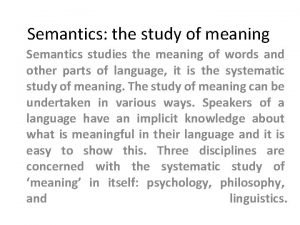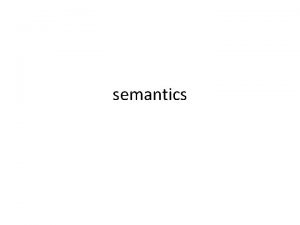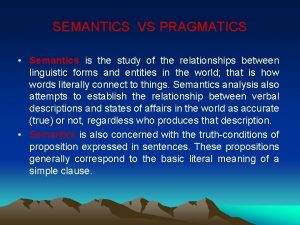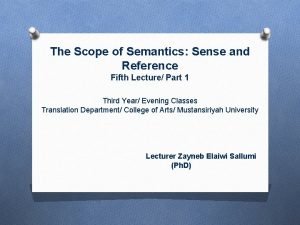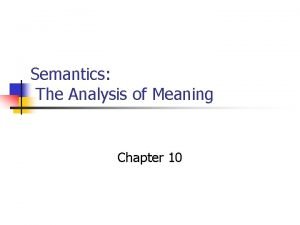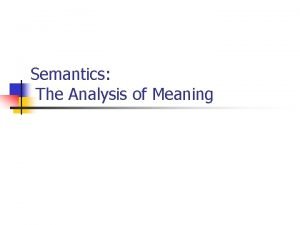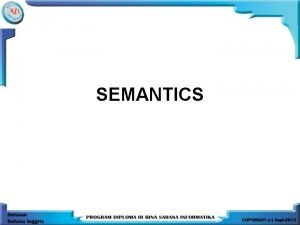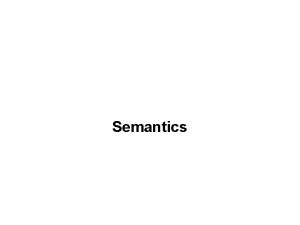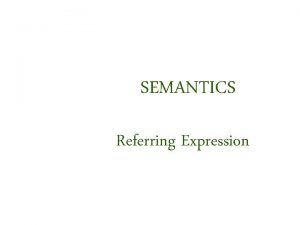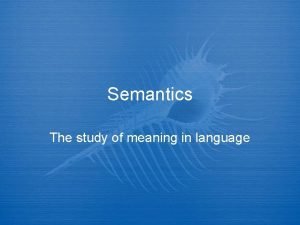V SEMANTICS 1 Semanticsthe study of meaning 2










- Slides: 10

V. SEMANTICS

1. Semantics—the study of meaning 2. Some views on semantics 2. 1 Naming things: Words are names of things, as held by Aristotle. 2. 2 Concepts The semantic triangle of Ogden and Richards Thought or reference Symbol Referent 2. 3 Context and behaviorism Some linguists think that meaning should be studied in terms of situation, use, and context — elements closely linked with language behavior. “Jill is hungry. She sees an apple and gets Jack to fetch it for her by speaking to him”.

2. 4 Mentalism Mentalists regard the task of semantics mainly as one to explain those data supplied by direct resort to intuition by constructing theories and descriptive rules and categories from which they can be deduced. 3. Lexical meaning 3. 1 Sense and reference Sense refers to the complex system of relationships that hold between linguistic elements themselves (mostly the words); it is concerned only with intra-linguistic relations. sense relations are in fact a part of the semantic structure of a language. Reference deals with relationship between the linguistic elements (words, sentences, etc ) and the non- linguistic world of experience

3. 2 Synonymy is used to mean ‘sameness of meaning’. English is rich in synonyms. has two sources: from Anglo-Saxon and from French, Latin and Greek Five types of synonyms: a) dialectal synonyms: lift/elevator; football/soccer. b) stylistic synonyms: words differing in ‘styles or registers’: gentleman (formal)/man (general)/chap (colloquial) c)emotive synonyms: words differing in emotive or evaluative meanings statesman (respectful)/politician (derogatory); hide (general)/ conceal (formal, with intention) d) collocation synonyms: rotten food (eggs, meat, etc); addled eggs; rancid bacon or butter; sour milk e) near synonyms: mature/adult / ripe / perfect/due; direct/control/determine/require

3. 3 Polysemy and homonymy Polysemy refers to the phenomenon that the same word has a set of different meanings that are related to each other. E. g. bank/bank Homonymy refers to the case that two or more meanings (which are unrelated to each other) may be associated with the same linguistic form. Homography: spelled in the same way, but pronounced differently. E. g. ; lead (noun)/lead (verb) Homophony: pronounced in the same way, but spelled differently. E. g. won/one; right/write 3. 4 Hyponymy Hyponymy refers to paradigmatic relation between a more specific lexeme, and a more general lexeme. The upper term is the “superordinate’ and the lower term is the ‘hyponym’. All the members that can be grouped under the same superordinate are called ‘co-hyponyms’. E. g. cat, animal; dog, hen, bird.

3. 5 Antonymy The word ‘antonymy’ is a standard technical term used for ‘opposite of meaning between lexemes. a) gradable opposites (antonyms) Two words may be seen in terms of degrees of the quality involved. E. g. wide/narrow, old/young, big/small. b) complementarity One member of the set is complementary to the other. E. g. single/married, alive/dead. opposites of this kind are called opposites. 3. 6 Relational opposites There is a relation indicating a contrast of direction in such a type of binary opposition. E. g. win/lose, parent/child, in front of/behind. 4. Componential analysis The total meaning of a word in terms of a number of distinct elements or components of meaning (semantic features), some or all of which will be common to several different lexemes in the vocabulary.

4. 1 Components of meaning One way of describing the components of a word is to use feature symbols. man: + HUMAN + ADULT + MALE woman: + HUMAN + ADULT – MALE boy: + HUMAN – ADULT + MALE girl: + HUMAN – ADULT – MALE 5. Sentence meaning 5. 1 How to define the meaning of a sentence? The meaning of a sentence is the product of both lexical meaning and grammatical meaning. In other words, it is the product of the meaning of the constituent lexemes and of the grammatical constructions that relates one lexeme syntagmatically to another. 5. 2 Selectional restrictions There are many constraints on what lexical items can combine with what others. These constraints are called selectional constraints because they can govern the selection of lexical items for insertion into underlying structure.

5. 3 Basic statements about meaning (X and Y may be assumed for the present to stand for arbitrary sentences) (i) X is synonymous with Y (I am an orphan VS I am a child and have no father or mother) (ii) X entails Y (I am an orphan entails I have no father) (iii) X is inconsistent with Y (I am an orphan VS I have a father) (iv) X is a tautology (This orphan has no father) (v) X is a contradiction (This orphan has a father) (vi) X (positively) presupposes Y (Is your father out presupposes You have a father) (vii) X negatively presupposes Y (If he had a father, things would be different negatively presupposes he has a father) (viii) X is semantically anomalous (This orphan’s father drinks heavily)

6. The semantic structure of sentences 6. 1 Extended use of componential analysis Argument and predicate are constituents of the predications expressed by sentences. Assuming that all predications can be divided up into arguments and predicates, we can then apply componential analysis onto these units and eventually obtain a set of semantic features. Predicates consist of arguments and predicates, which again consist of features. 6. 2 Predication analysis refers to the analysis which involves breaking down the predications into their constituents—arguments and predicates. Predications containing two arguments, one argument, or no argument are called a two-place predication, one- place predication, and a no-place predication respectively.

The predicate can be regarded as the main element of the predication, for it includes tense, modality, etc. It may also be said to govern the arguments, for it determines the number and nature of the arguments. 6. 3 Advantages of predication analysis The componential analysis with the addition of predication analysis can serve as an adequate semantic theory to provide semantic representations for whole sentences. It can also enable us to make predictions regarding entailment, inconsistency, contradiction and other semantic relations. 6. 4 Books for further reading: 1. Lyons, J linguistic Semantics: An Introduction. Beijing: FLT & P Press, 2000 2. Saeed. J. I. Semantics. Beijing: FLT & P Press 2000

